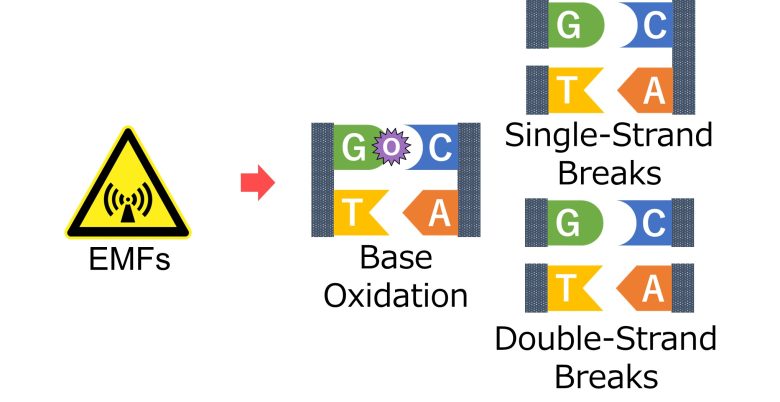DNA Damage
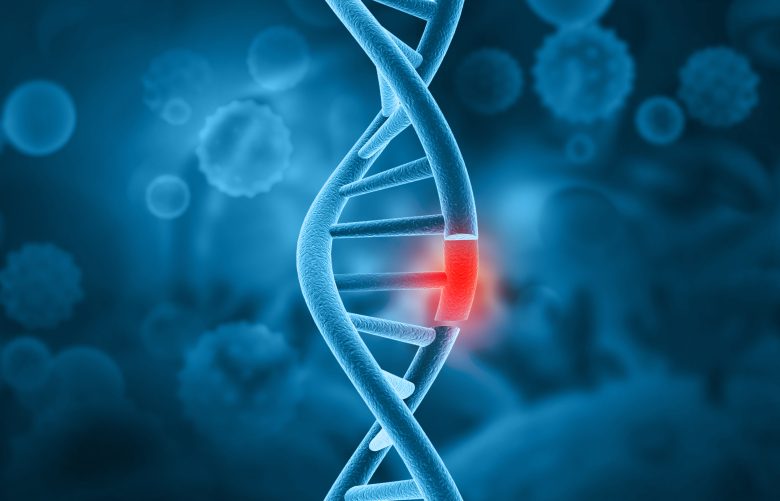
First, I will explain DNA damage caused by reactive oxygen species (ROS).
I will then present studies showing that EMFs did indeed cause DNA damage.

Table of ContentsAll_Pages
What is DNA?
A single strand of DNA consists of phosphoric acids and sugars that serve as the backbone, and bases that hold the genetic information. Two these strands face each other to form DNA double strands.
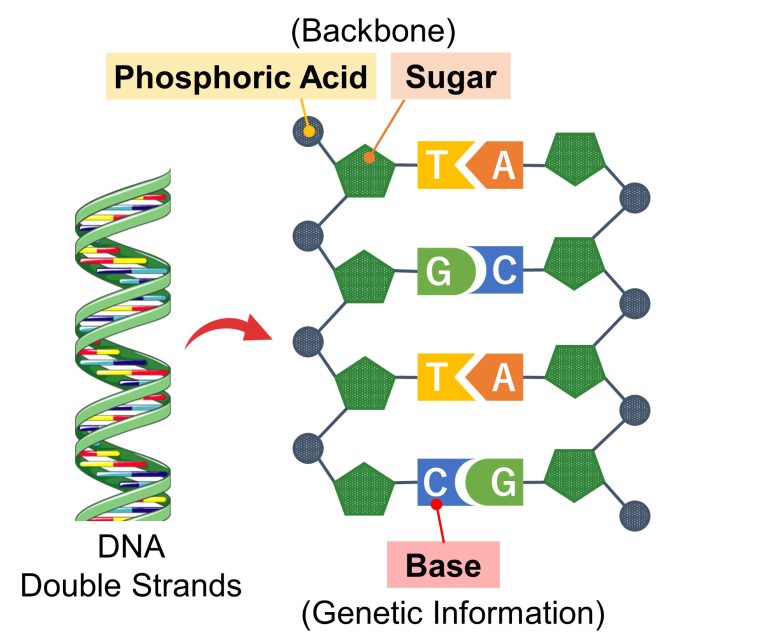
There are four types of bases: guanine, thymine, cytosine, and adenine. Guanine is paired with cytosine and thymine with adenine.
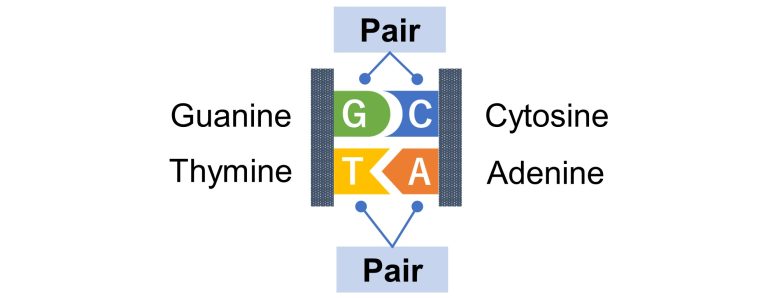
Because of this nature, the contents of one strand of DNA can be predicted from the contents of the other strand.
Therefore, you can say that the two strands of DNA hold practically the same genetic information.
What Bases of DNA Represent
The sequence of three bases in DNA represents a single amino acid.
For example, the sequence of cytosine-adenine-adenine (CAA) represents glutamic acid, while the sequence of guanine-adenine-adenine (GAA) represents glutamine.
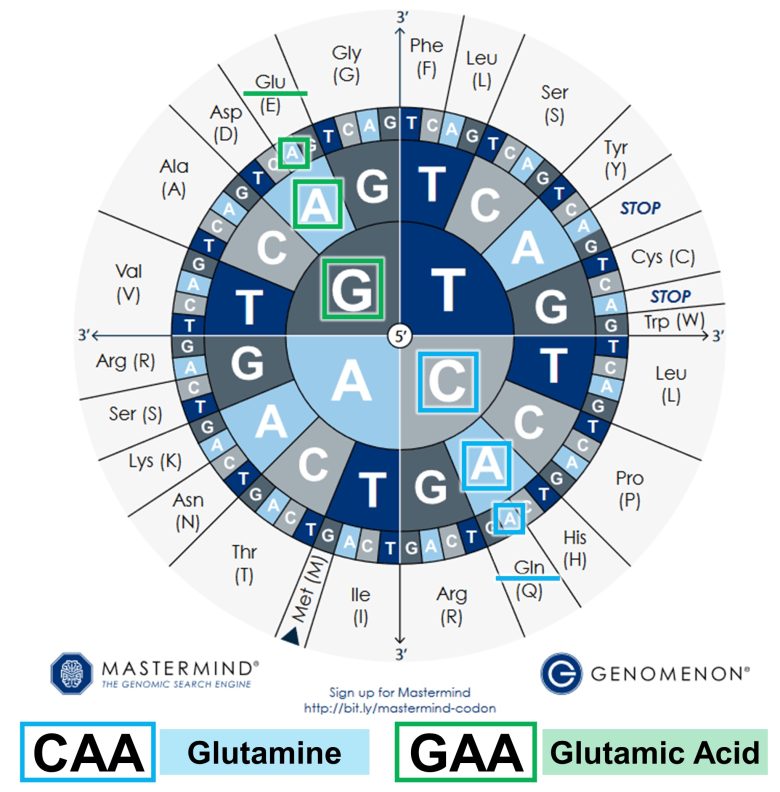
( Cited and Modifed from GENOMENON )
For example, when the sequence of bases in DNA is GAA, TGT, and GGT, amino acids glutamic acid, cysteine, and glycine are produced, respectively.
When these amino acids are linked together, they form glutathione, a protein (peptide) that functions as an antioxidant.
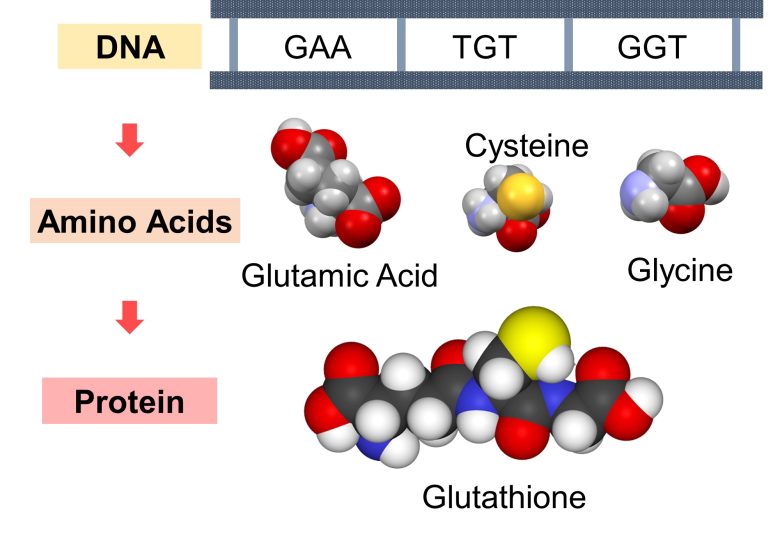
Therefore, we can think of DNA as the blueprint of proteins. (*)
In humans, however, only 1.5% of DNA codes for proteins. Other known regions include those that code for functional RNA molecules and regulatory regions for DNA such as promoters, but the majority of these regions remain to be solved.
These proteins become materials for muscle, bone, and skin; enzymes for metabolic activities and signaling; transporters of oxygen and lipids; and antibodies important for immune responses.
Proteins thus assume a variety of important functions in living organisms.
DNA Damage and Health Effects
When mutations occur due to DNA damage, the proteins produced become denatured, and their characteristics change.
Or the normal amount of protein is no longer produced. In other words, the amount produced becomes abnormally high or low.
The cells then become dysfunctional, and this consequently affects human health.
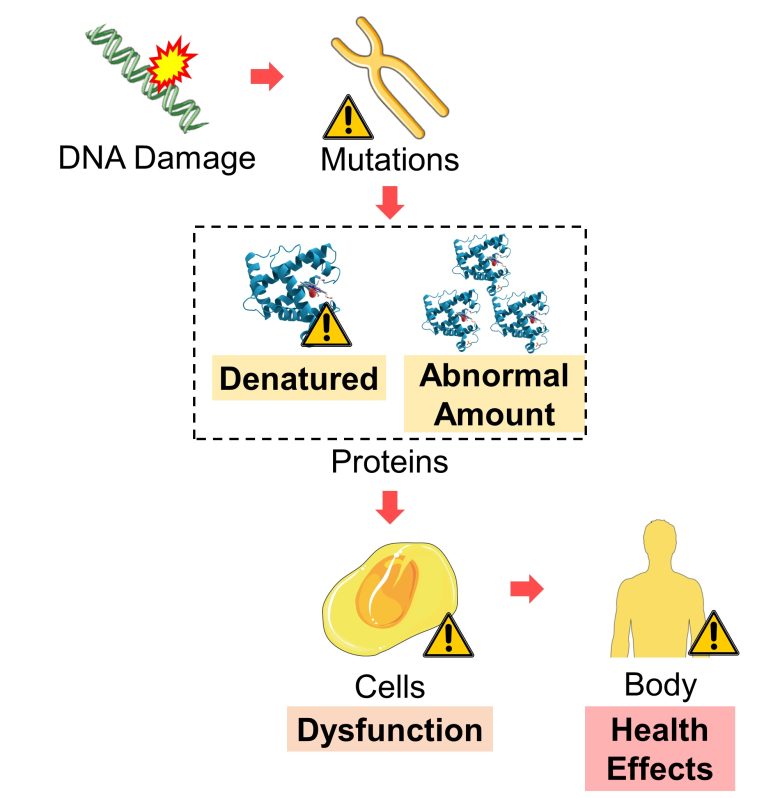
As will be discribed later, DNA damage also causes replication stress, cell cycle arrest, and other reactions that disrupt the progression of cellular activities, which also cause cellular dysfunction.
Types of DNA Damage
There are mainly four types of DNA damage caused by ROS, all of which are brought about by hydroxyl radicals, the most harmful of all ROS.

Base Oxidation
It is the one where a hydroxyl radical has attached to a base and oxidized it. Guanine is the primary target.
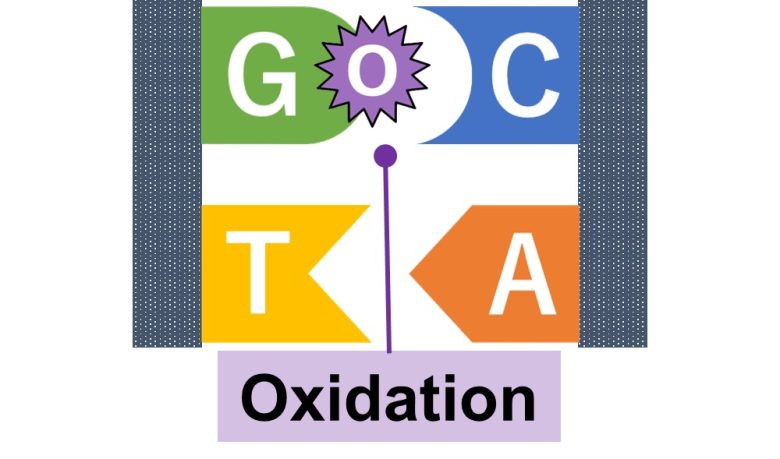
Base Loss (Abasic Site)
It is the one where a hydroxyl radical has attached to the root of a base and detached the base, resulting in the loss of the base.
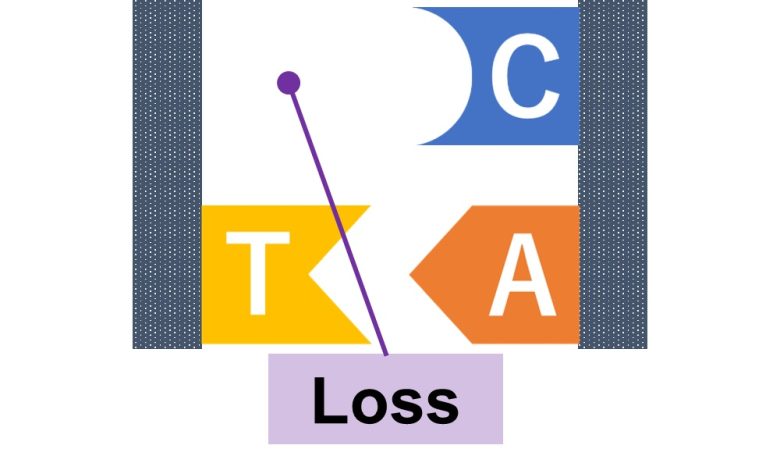
Single-Strand Break
It is the one where a hydroxyl radical has attached to the backbone of DNA and broken a single strand.
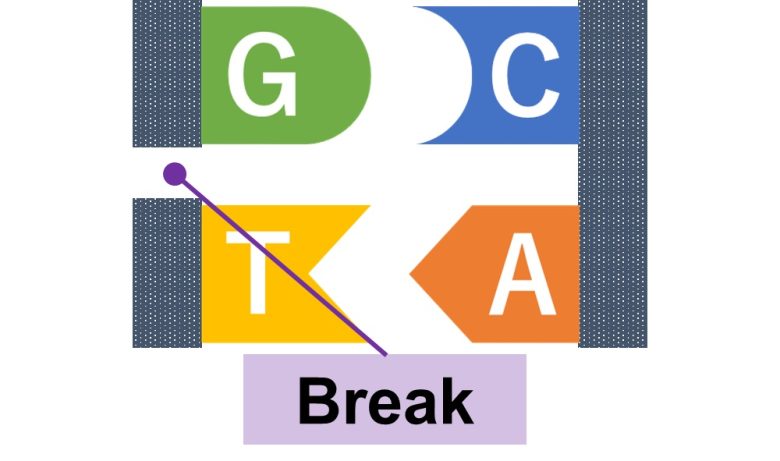
Double-Strand Break
It is the one where single-strand breaks have occurred at the same location. The frequency of occurrence is very rare.
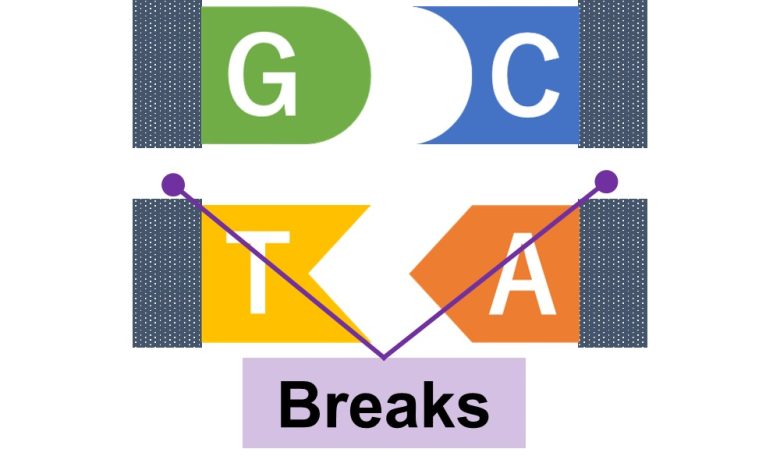
Cell Cycle
The series of processes required for one cell to divide into two cells is called the cell cycle. The human cell cycle is approximately 24 hours.
The cell cycle consists of the following four phases:
- G1 phase, the period when the cell grows.
- S phase, the period when the DNA is synthesized (replicated).
- G2 phase, the period when the cell grows again.
- M phase, the period when the cell divide.
The period when the cell rests without dividing is called the G0 phase.
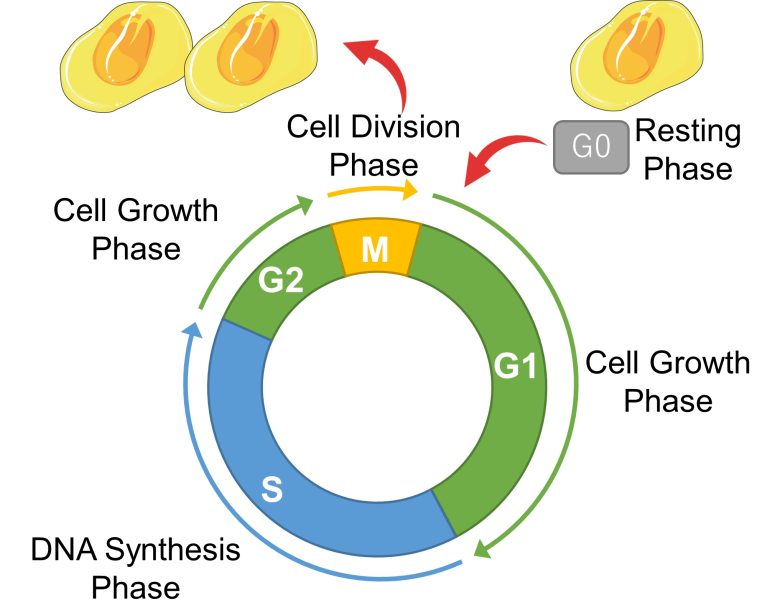
Mutations Occur in DNA Synthesis Phase
DNA damage occurs routinely, with base oxidation occurring 11,500 times per cell per day, base loss (abasic site) 9,000, and single-strand breaks about 10,000. (Helbock et al. 1998, Nakamura et al. 1998, Hossain et al. 2018)
However, these DNA damages are constantly being repaired and restored.
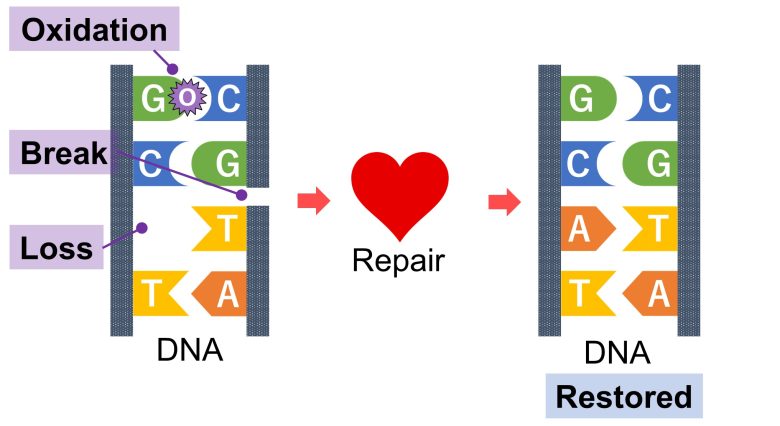
However, if repair is not completed in time and these damages are carried into the DNA synthesis phase, mutations occur.
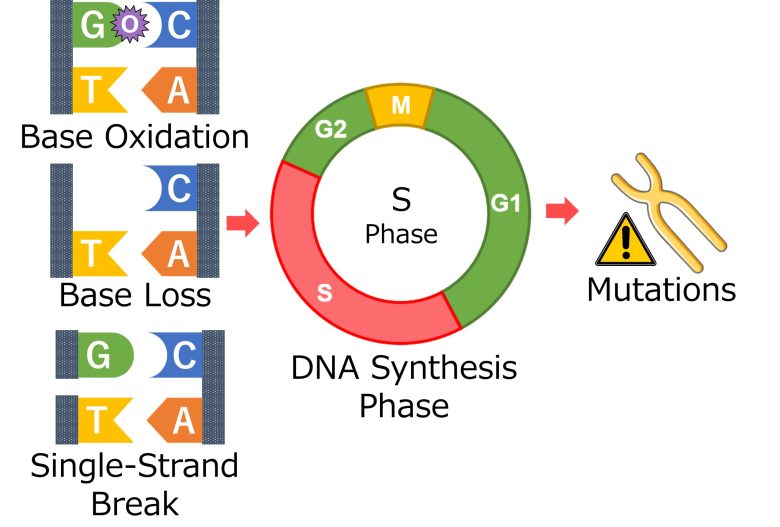
For double strand breaks, the number of occurrences is 50 per cell per day (Vilenchik and Knudson 2003), which is very low compared to other damages.
However, double-strand breaks are fatal to cells, causing large-scale mutations called chromosome abnormalities at the time they occur.
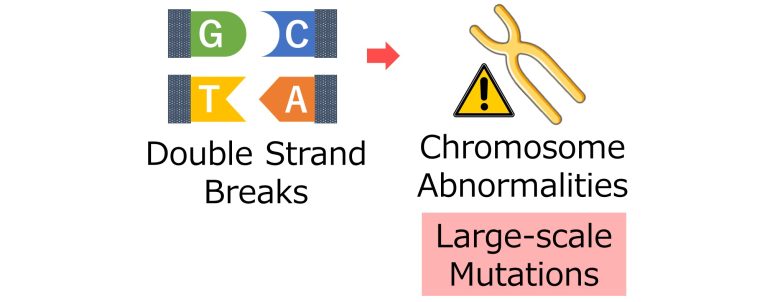
How mutations arise from DNA damage is explained on the next page.
DNA Damage by EMFs
Here, I will present studies showing that DNA damage occurred with EMF exposure.
Studies
Gürler et al. 2014
Rats aged 5-6 months, equivalent to adolescents, were exposed to pulse-modulated 2.45 GHz RF-EMFs with a strength of 3.6 μW/cm2 for 1 hour per day for 30 days.
As a result, ROS increased and DNA oxidation increased in the brain and blood.
Also, treatment with garlic, which has antioxidant properties, suppressed the damage above.
Increase in ROS
TBARS, a marker for lipid peroxidation, increased by 20% with the EMF exposure. Garlic, which has antioxidant properties, suppressed it to some extent.
Increase in DNA Oxidation
Zhang et al. 2016
For study participants recruited at the First Hospital of Jilin University, China, ROS increased and DNA oxidation increased in urine when they were occupationally exposed to EMFs from high-voltage lines.
Also, intake of green tea polyphenol supplements, which have antioxidant properties, suppressed the damage above.
Increase in ROS
Isoplastane, a marker for lipid peroxidation, increased by 50% with the exposure to EMFs from high-voltage lines. Green tea polyphenol supplements, which have antioxidant properties, suppressed it.
Increase in DNA Oxidation
8OHdG, a marker for DNA oxidation, increased by 40% with the exposure to EMFs from high-voltage lines. Green tea polyphenol supplements, which have antioxidant properties, suppressed it.
Lai and Singh 2004
Rats aged 8-12 weeks, equivalent to adolescents, were exposed to 60 Hz ELF-EMF with a strength of 500 μT for 2 hours.
As a result, DNA single-strand breaks and double-strand breaks in the brain increased.
Also, treatment with vitamin E and iron chelators (*), which have antioxidant properties, suppressed the damage above.
By sequestering iron ions, the reaction that transforms hydrogen peroxide into hydroxyl radicals is suppressed.
Electrophoresis of the cells is used to detect DNA breaks. In electrophoresis, the more the DNA breaks, the longer the length of DNA migration.
Increase in DNA Breaks
Also, rats aged 8-12 weeks, equivalent to adolescents, were exposed to 60 Hz ELF-EMF with a strength of 10 μT for 24-48 hours.
As a result, DNA single-strand breaks and double-strand breaks in the brain increased as the exposure time increased.
Increase in DNA Breaks
Rageh et al. 2012
Rats aged 1 week, equivalent to infants, were exposed to 50 Hz ELF-EMFs with a strength of 500 μ for 24 hours per day for 30 days.
As a result, DNA breaks in the brain increased.
Increased in DNA Breaks
Various degrees of DNA breaks increased with the ELF-EMF exposure.
Ding et al. 2018
For men attending a genetics clinic in Shaanxi, China, ROS and DNA oxidation and breaks in their semen increased, sperm count decreased, and sperm motility decreased as the time they were exposed per day to the EMFs increased, emitted from smartphones, cell towers, and Wi-Fi.
Increase in ROS
Decreases in total antioxidant capacity and antioxidant activity mean an increase in ROS.
Increase in DNA Oxidation
8OHdG, a marker for DNA oxidation, in semen increased by 50% with the EMF exposure for more than 2 hours per day, emitted from cell phones, cell towers, and Wi-Fi.
The comet assay is used to detect DNA breaks. In the comet assay, the more the DNA breaks, the more the tail DNA, the less the head DNA, and the larger the olive tail moment.
Increase in DNA Breaks
Decrease in Sperm Count
The sperm count decreased by 70% with the EMF exposure for more than 2 hours per day, emitted from cell phones, cell towers, and Wi-Fi.
Decrease in Motility
Kumar et al. 2014
Cell phones with a local SAR of 1.34 W/kg were placed and kept in talk mode for 2 hours per day, and male rats aged 10 weeks, equivalent to adolescents, were exposed to their EMFs in close proximity for 60 days.
As a result, ROS and DNA breaks in the sperm increased, and sperm count decreased.
Increase in ROS
TBARS, a marker for lipid peroxidation, increased by 60% due to the exposure to the cell phone EMFs.
An Increase in lipid peroxidation means an increase in ROS.
The comet assay is used to detect DNA breaks. In the comet assay, the more the DNA breaks, the further the tail migration, the longer the tail length, the more the %DNA in tail, and the larger the olive tail moment.
Increase DNA Breaks 1
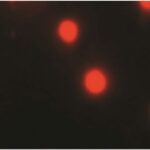
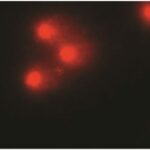
In the comet assay, tail migration, a marker for DNA breaks, increased due to the exposure to the cell phone EMFs.
Increase DNA Breaks 2
Decrease in Sperm Count
The sperm count decreased by 20% due to the exposure to the cell phone EMFs.
That's all for the presentation of the studies.
We have confirmed that EMFs can indeed cause DNA damage, such as base oxidation, single-strand breaks, and double-strand breaks.
